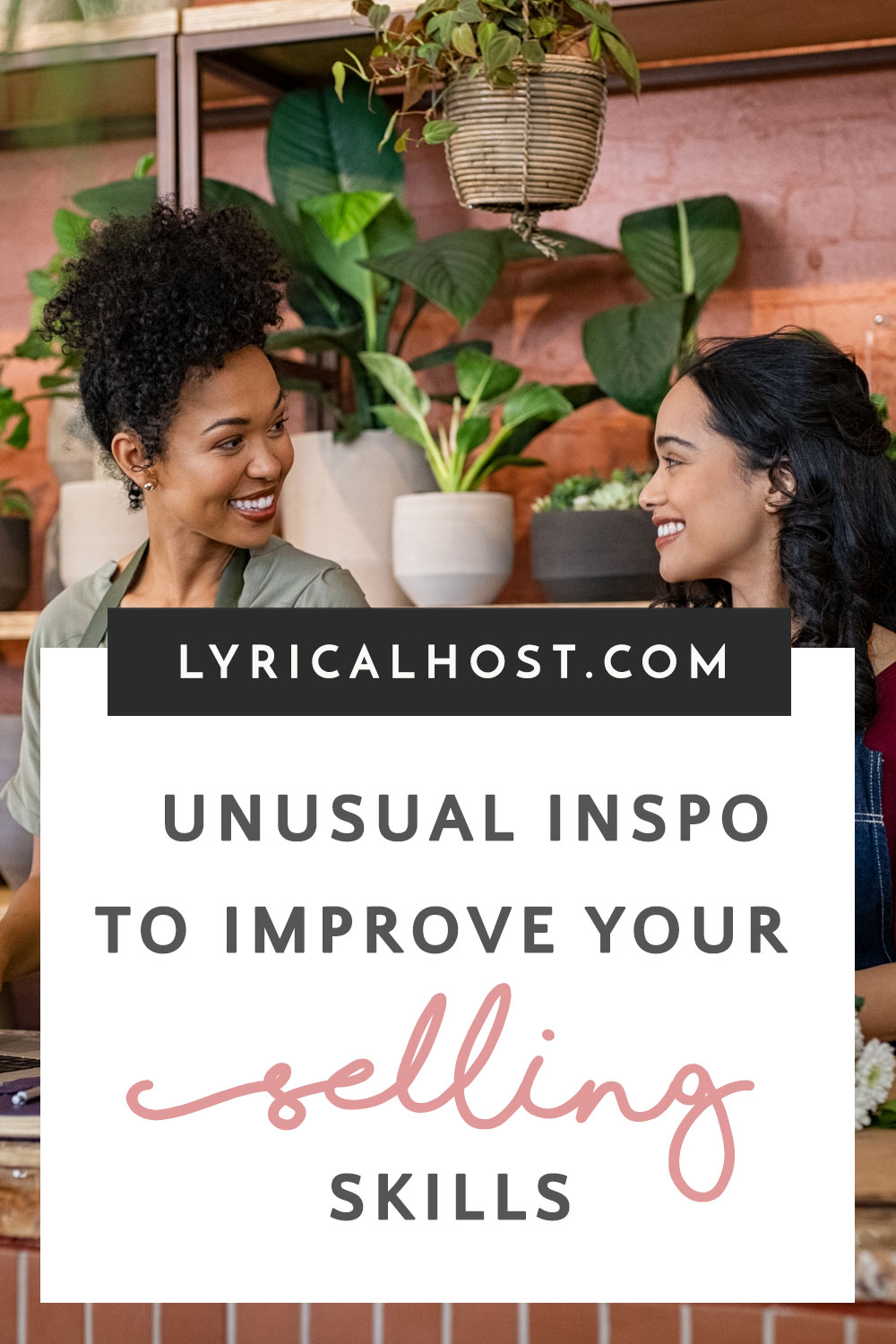Whether you’re creating a landing page, preparing a workshop, writing copy, or telling someone in person about your blog or business, it can sometimes feel kind of awkward.
Even if you’ve read tons of books and blog posts, watched videos and listened to podcasts, it’s still very different to be hearing about someone’s experience or approach compared to seeing it first hand and figuring out what works, what doesn’t, and what could help you.
Online selling can sometimes feel pretty samey (or dramatic!), especially with people hopping on board bandwagons. So we’ve rounded up some slightly unusual sources of inspiration, ideas and approaches for you to look out for or track down in everyday life.
Currently reading: 7 Unusual Sources To Improve Your Selling Skills Click To TweetWe’ve included a mix of direct selling skills and persuasive techniques that cover all kinds of different language types and contexts. While it’s unlikely you’ll be using many of them directly as they stand, there are definitely things you can take away from them to adapt for yourself – whatever you’re selling, and however you’re selling it.
As with everything – test what works for yourself. Have a think about what you can use and how; we’ve included some potential options, but the possibilities are endless!
In no particular order…
01. Shopping channels
TV shopping channels such as QVC sell round the clock, so you can grab inspiration whenever the mood strikes, right from the comfort of your home. There may be techniques you definitely want to use in your own business, and there may be ones you definitely want to avoid; either way, making it a conscious choice always helps!
Live shopping channels are a great way to see how people perform under pressure and use classic selling skills in the real world. If you hop on Lives, live webinars, workshops, or do live talks, these are a great way to see unedited persuasive techniques in the wild. And to see that even the pros aren’t perfect and make mistakes!
They’re also a good opportunity to consider how people build rapport with and sell to someone they can’t see in real life, and how they communicate with other presenters around them.
Pre-recorded shows and infomercials can also be interesting. With as many takes and as much editing and post-production (such as adding presentation-style pricing and graphics) as they like, the “polished”
Some things to look for:
- The relationship between features and benefits.
- Creating a sense of trust.
- How urgency is used.
- Creating a face-to-face feel despite screens and distance.
How you could spark ideas from this source:
- General skills practice: Think about how you’d pitch the exact same item they’re selling, or what landing page features or copy you’d use.
- Re-evaluating, developing or adjusting the way you present benefits and features.
- Listing what’s interesting/exciting about what you sell and how you can make more of that.
02. Markets
Indoor and outdoor markets are one of the most long-standing and traditional forms of selling. But there’s still a lot to learn here, even if you sell digital services.
One of the key things is how stall holders get people’s attention, especially in situations where they’re competing for that from other stalls. This may be physically shouting, but it may also be about signage, promotions, eye-catching decoration and displays, and so on.
Some things to look for:
- How attention is attracted, and how that can translate to your own business.
- Pricing and deals used, especially multi-buys and minimum purchase quantities.
- How discounts are used near the end of the day.
How you could spark ideas from this source:
- Ideas for adding extra value through freebies, samples, and ‘I’ll throw in’s.
- Inspiration for visual presentation.
- Friendly rapport and quickly building relationships.
03. Trailers
Going back to screens, but in a slightly different way to normal, we have movie trailers.
Movie trailers are surprisingly varied in their approaches for such short pieces of content. Some try to tell the whole story of the movie, some base it around a single sentence or idea, some pick the most action-based, intriguing, or dramatic elements.
Some things to look for:
- How movie trailers vary depending on the type of audience they’re targeting (especially for different stereotypes and genres).
- How movie trailers appeal to multiple target audiences at the same time (for example the way in which many animated movie trailers are designed to appeal to their target audience of children, but also adults as the purchaser).
- Any particular areas of impact you feel the trailer has.
How you could spark ideas from this source:
- Inspiration for calls to action.
- Incorporating familiar, safe elements to what you’re presenting without eliminating novelty.
- Ideas for condensing material and getting the point/idea across in a small amount of time/space.
04. Church services
This may seem like a strange one given that churches aren’t traditional commercial companies. However, there are all kinds of paths of inspiration on offer, including public speaking skills, the power of story, how interest in what’s being said is initiated and held, struggle and solution frameworks and more.
One of the key ways religious services can be different to the other sources of inspiration listed here is that many are very focused on creating an uplifting community spirit. This is often done through song, atmosphere and surroundings. A main reason that people go to services is to feel a certain type of way, and this is something you may be able to take and explore further in your own services.
Many church services are streamed online if you prefer that to going in person.
How you could spark ideas from this source:
- Brainstorming ways you can create an uplifting message through your content.
- Exploring a new struggle/solution framework or balance.
- Building relationships with your community or target audience.
05. Billboards
One of the more obvious sources of inspiration, billboards are the predecessor to the standard online display advert.
Billboards are simple in that they’re an extremely passive form of advertising. They’re not in your face like an online pop up, there’s no catchy music or appealing voice/over. They rely on you noticing, and they rely on you caring enough to keep reading. And they rely on that at scale, to be seen by enough people to make them worthwhile.
These days, billboards, along with other print forms, can be seen as something of a status symbol. Entrepreneurs want to share that they have a billboard and take photos of it/them. This means that they often get repurposed into digital content, often in the form of social media or press images.
Billboard concepts are kept very short and simple. Some just get straight to the point with a name and call to action, whereas others aim for intrigue and play on brand recognition. Seeing what visuals are used, and how, can also inspire you…or help you confirm what you don’t like.
Some things to look for:
- How online adverts have impacted the design and style of billboards (or if not, how they’re fiercely traditional!)
- Visual techniques – whether traditional or innovative
- How clever/memorable the hook or message is
- Which billboards are the most famous and why.
How you could spark ideas from this source:
- Searching for billboards and visual adverts from different countries to see the different approaches.
- Using microcopy and reducing the amount of text you use to make your point.
- Applying techniques for social media networks and meta descriptions that have limited character lengths.
06. Political speeches
(some things to look for: persuasive techniques, the individual vs the masses,, the use of positive and negative).
Some things to look for:
- Repetition and pauses.
- Tripartite structures (a list of three things), which sounds more persuasive and pleasing in both written and spoken language.
- Use of analogies and metaphors, especially familiar ones.
- Us vs them – how is it used, positively or negatively?
- The individual vs the masses – and how the speaker moves between the two.
- Techniques used to make you feel like you’re being personally addressed.
How you could spark ideas from this source:
- Utilizing the “easy yes” in your business – things that a majority of people support or like and will help increase affinity. This can be especially effective on social media where people will quickly like or heart posts they agree with.
- Consider how you use pauses (online, these can be represented by white space or line breaks).
- Using short, impactful sentences, especially at the end of paragraphs or as standalone statements.
07. Poetry
This one may seem out of left field – we’re definitely not suggesting you write a rhyming sales page or anything like that! – but the rhythmical tone of poetry and its imagery can inspire your own writing.
Some of the best poetry is simple but powerful, which makes it ideal for tag line and header inspiration.
As poetry spans centuries, it’s worth dipping in and out of older and more recent works by poets of completely different styles to see what you/your audience find appealing. Don’t forget that poets include rappers and many other types of song writers too!
Some things to look for:
- Convincing linguistic techniques such as lists of three/tripartite structures (as above).
- Use of similes and metaphors.
- How different senses are called upon, especially more unusual ones like smell.
- Rhythm and sentence length.
How you could spark ideas from this source:
- How you can form imagery through words and how that describes an experience or feeling you want your audience to experience.
- How the same image or idea is carried throughout, either through repetition or in a different form. How can you use this to be persuasive in your sales content?
One more thing…
For the sources above, consider:
- What emotion/s are being presented to you by the speaker/author?
- How does the speaker/author want you to feel, and why?
- What are the common/repeated themes in what’s being said?
- How effective are the persuasive techniques – do you feel persuaded?
- Would you describe it as a positive or negative message, or both? (For example you feel reassured, or scared, or you’ve been led on a journey from problem to solution).
What are some interesting and unusual sources of sales inspiration and persuasive techniques have you come across? Let us know in the comments!
If you found this post interesting, please pin it for someone else:







No Comments